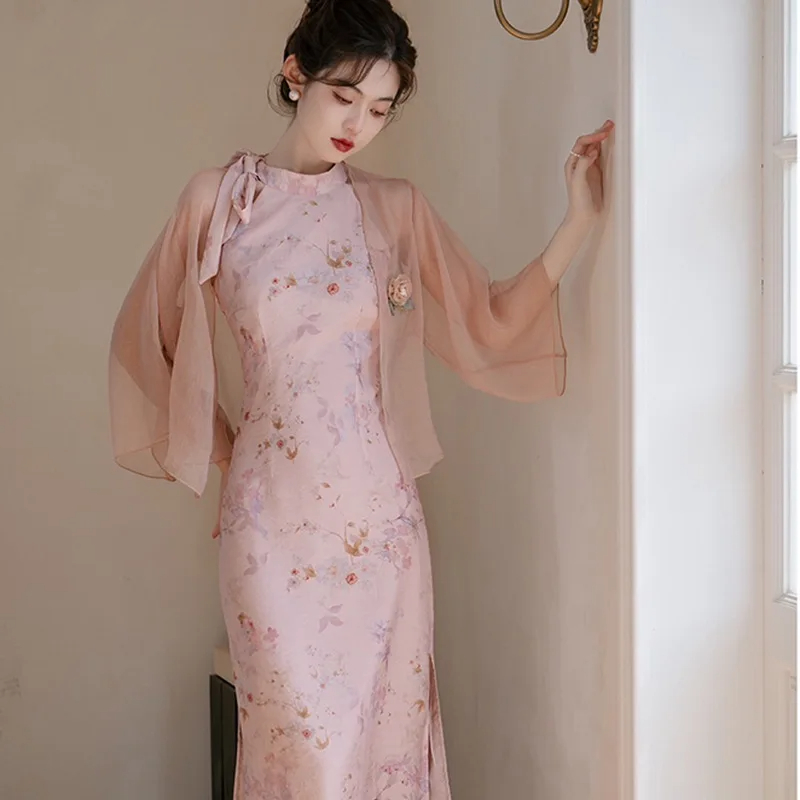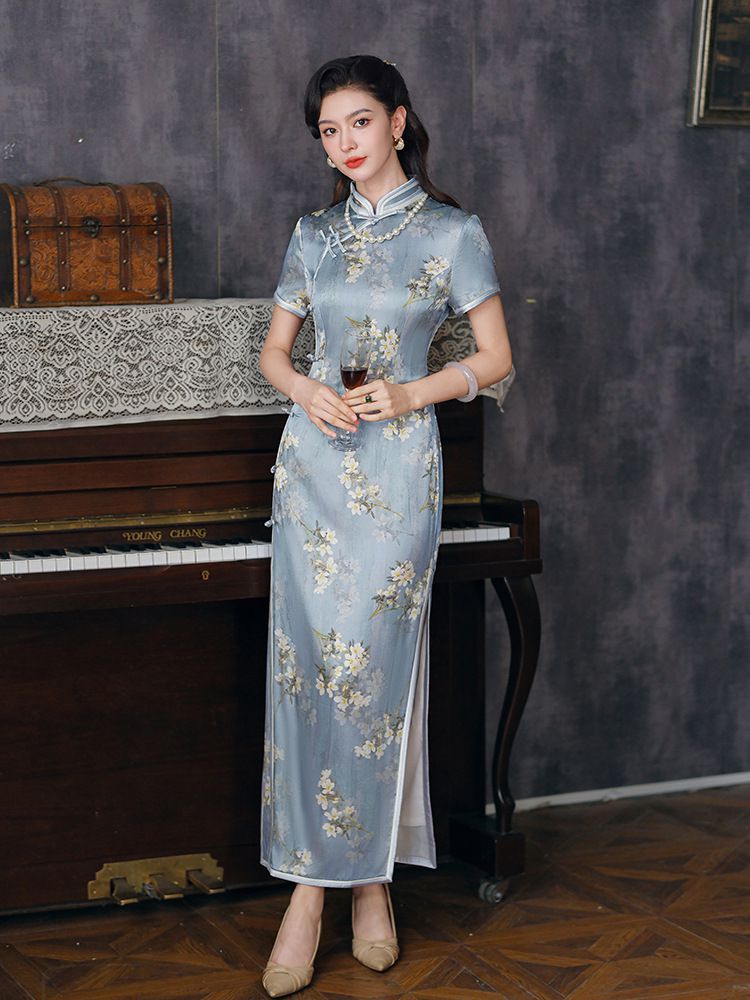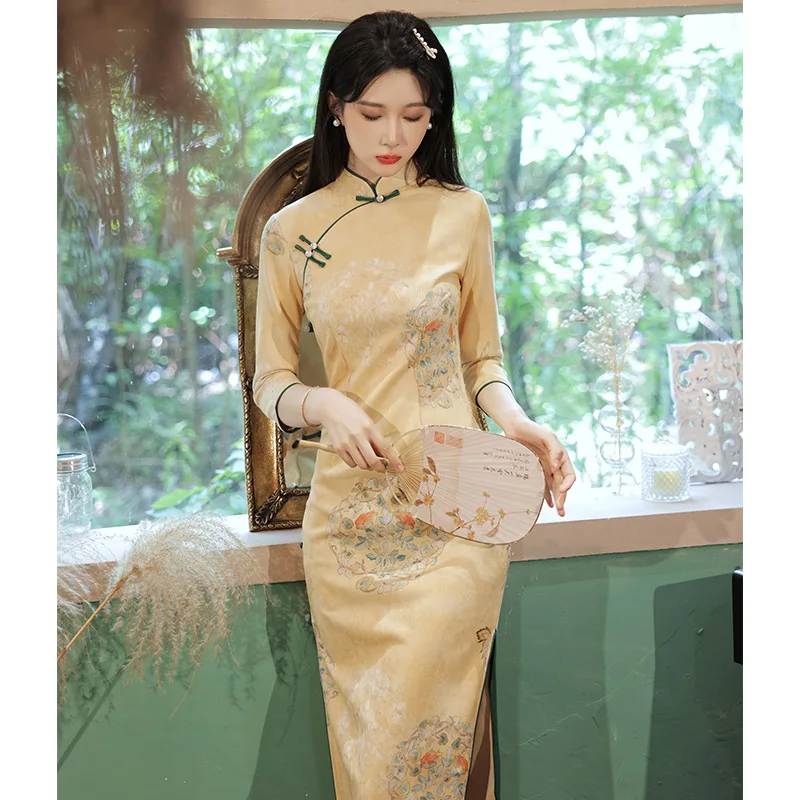Floral Embellishments: Enhancing 旗袍 Elegance with Intricate Flower Patterns
Flower patterns have long been a key element of qipao design, adding an aura of elegance and femininity to this traditional Chinese 穿衣. The intricate embroidery and vibrant hues used in these floral embellishments create a mesmerizing visual display, elevating the overall beauty of the qipao.

Nature-Inspired Designs
The inspiration for qipao flower patterns is often drawn from nature. Designers frequently look to the delicate petals of roses, the graceful curves of orchids, and the vibrant colors of peonies. These natural elements are transformed into intricate embroidery, meticulously stitched onto the fabric of the qipao.
Strategic Placement of Floral Patterns
The placement of floral motifs is crucial in qipao design. Traditionally, these embellishments are found along the neckline, cuffs, and hemline, creating a balanced, harmonious look that accentuates the wearer’s figure. However, modern designers have experimented with unconventional placements, like asymmetrical patterns or bold floral motifs that cover the entire dress, adding a fresh, contemporary twist.
Color Choices and Their Meanings
Colors also play a significant role in enhancing the flower patterns on qipaos. Vibrant shades of 红, 粉红色, and 黄的 evoke feelings of joy and celebration, while softer tones like 蓝, 绿化, and purple create a serene, elegant aesthetic. Some designers even combine multiple colors to achieve a rich, visually appealing effect.
Symbolism of Flowers
Beyond their aesthetic appeal, flower patterns on qipaos carry symbolic meanings. For example, the peony represents wealth and prosperity, while lotus flowers symbolize purity and enlightenment. By incorporating these motifs, qipao makers not only enhance the garment’s visual beauty but also imbue it with a sense of good fortune.
Botanical Motifs: Nature’s Inspiration for 现代 Qipao Designs
Flower Pattern Inspiration for Qipao Design
The qipao, a symbol of Chinese elegance, has experienced a resurgence in modern fashion. Designers today often find inspiration in nature, particularly in the vibrant colors and intricate patterns of flowers.

Historical Roots in Chinese Art
Floral motifs have long held significance in Chinese culture, dating back to the Song Dynasty (960-1279). During this period, flower patterns appeared frequently in textiles, ceramics, and paintings. Popular flowers such as the peony, lotus, and chrysanthemum each symbolized prosperity, purity, and longevity, respectively.
Contemporary Flower Patterns
Incorporating these time-honored motifs, today’s designers blend traditional and modern aesthetics in qipao design. For example, the peony is often used in evening gowns for its lush, vibrant petals, while the lotus appears in more formal designs, emphasizing grace and elegance.
Modern Floral Inspirations
Western Floral Influence
Contemporary qipao designers aren’t limited to traditional Chinese flowers. Western floral motifs such as roses, lilies, and orchids have found their way into qipao designs. These flowers often inspire more romantic and feminine aesthetics, offering a fresh take on this classic garment.

Floral Embellishments in Modern Qipaos
In addition to using floral patterns in fabric design, modern qipaos often feature intricate embellishments like embroidery, beading, and appliqué. These embellishments add an extra layer of luxury and sophistication, giving the dress an artistic flair. For example, a qipao adorned with embroidered peonies presents a more formal and traditional appearance, while one embellished with beaded lilies provides a romantic and softer look.
Versatility of Flower Patterns in Qipao Design
The versatility of flower patterns in qipao design is vast. Designers skillfully use flowers to create different visual effects, whether through intricate embroidery, bold beadwork, or delicate appliqué. The choice of floral embellishment can transform a qipao, making it suitable for various occasions, from formal events to everyday wear.
Cultural Fusion: Integrating Traditional Flower Patterns into Contemporary Qipao Styles
Global Inspirations in Qipao Design
As the qipao continues to evolve, contemporary designers are integrating flower patterns from other cultures into their designs. Japanese cherry blossoms and Indian lotus motifs, for instance, add a rich cross-cultural element. This fusion creates a unique and eclectic style that speaks to a global audience while preserving the essence of the qipao.

Enduring Appeal of Floral Motifs
The use of flower patterns in qipao design speaks to the garment’s timeless appeal. By blending traditional Chinese symbols of beauty and prosperity with modern and international influences, qipao designers create dresses that are not only visually striking but also rich in cultural significance.
Timeless Elegance: The Role of Flower Patterns in Qipao Evolution
Flower Patterns in Traditional and Modern Qipaos
The evolution of flower patterns in qipao design reflects the changing fashion landscape while preserving cultural heritage. In traditional qipaos, flowers were meticulously embroidered, showcasing the craftsmanship and attention to detail of Chinese embroiderers. Modern qipao designs, however, often push boundaries by using bold floral motifs and unconventional fabric placements, making each garment a unique expression of both tradition and innovation.

Symbolism in Contemporary Floral Motifs
While the floral motifs in modern qipaos may differ in style, their symbolic meanings remain deeply rooted in Chinese culture. Flowers like peonies, lotuses, and chrysanthemums continue to represent wealth, purity, and longevity, ensuring that the qipao remains a garment imbued with meaning and cultural value. In today’s designs, these flowers are sometimes mixed with Western-inspired blossoms to create a harmonious blend of cultures, making the qipao more accessible and appealing to international audiences.
Craftsmanship and Innovation: The Making of Floral Qipaos
Intricate Embroidery Techniques
The skill of Chinese embroiderers is showcased in the complex flower patterns adorning qipaos. Each stitch is precisely placed to create a harmonious and visually stunning design. Whether the flower pattern is delicately embroidered with thin silk threads or highlighted with bold, vibrant colors, the craftsmanship of the embroiderer brings the design to life.

Modern Techniques and Materials
While traditional embroidery remains a hallmark of floral qipaos, modern techniques such as digital printing and fabric manipulation allow for even more elaborate and diverse designs. Materials like silk, velvet, and lace are paired with advanced technologies to create patterns that were once impossible to achieve by hand, pushing the boundaries of traditional qipao-making while maintaining the elegance and femininity that the flower motifs represent.
Conclusion: Flower Patterns – The Heart of Qipao Elegance
Flower patterns have been and continue to be a vital component in enhancing the elegance of qipaos. From their symbolic meanings to the intricate craftsmanship involved in their creation, these floral embellishments are a testament to the artistic legacy of Chinese culture. As qipao design evolves, incorporating both traditional and global floral motifs, these timeless patterns ensure the dress remains a symbol of beauty, femininity, and cultural pride.
In every stitch, bead, and appliqué, flower patterns bring life to the qipao, making it a masterpiece of fashion and culture. Whether in a traditional setting or as part of a modern fusion, the floral qipao stands as an enduring icon of elegance.
